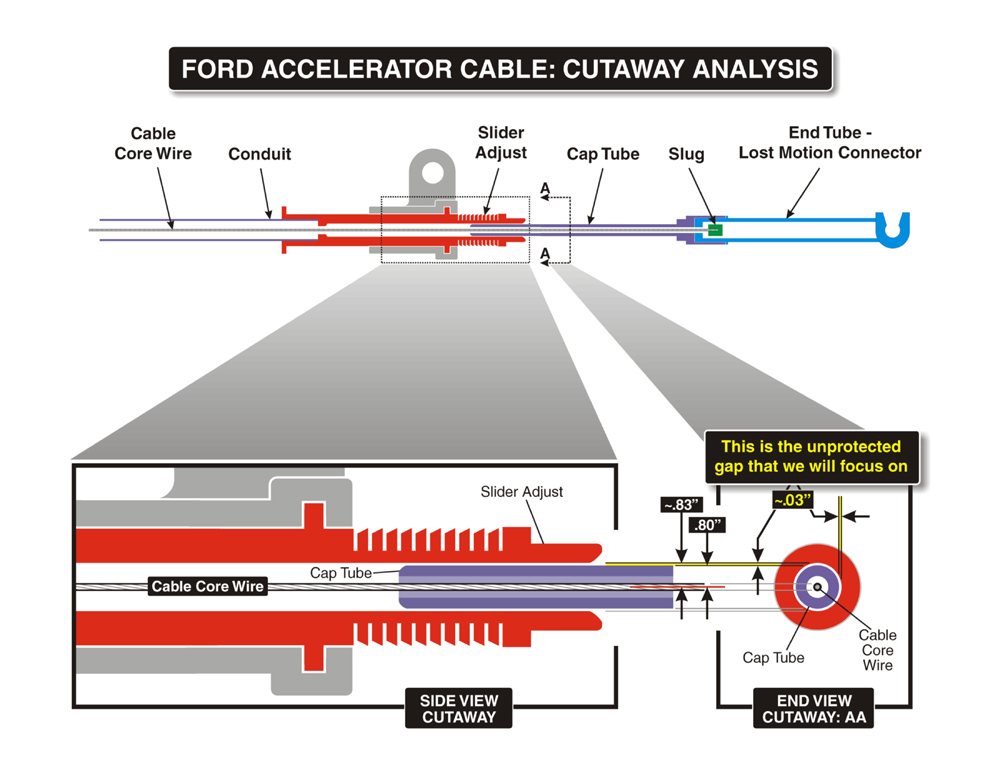Client: Michie Hamlett Lowry Rasmussen & Tweel, Charlottesville, VA
Summary: Rushed analytical graphic presentation for wrongful death trial against Ford Motor Co.
Result: A very happy client:
“You undertook this difficult task and, working under a very tight deadline, produced graphical depictions of the mechanical components that very accurately show their functions and operating ranges. The federal judge deemed them reliable and, in a startling courtroom admission, Ford’s own expert acknowledged their accuracy and effectiveness. This is a tribute to your quick grasp of the specifications and your tireless work in getting the job done.”
– Edgar F. Heiskell III, lead attorney
Contents
(1) Background
(2) I was retained by the law firm representing the victim’s family
(3) The results
(4) The presentation I created
(1) Background
The speed control cable of a Ford Explorer got stuck in the open-throttle position, preventing the North Dakota man who was driving it from being able to decelerate. He lost control in a curve, and was killed when his vehicle struck a tree, head-on.
The victim’s family retained Michie Hamlett Lowry Rasmussen & Tweel, one of Central Virginia’s largest law firms, to pursue a claim against Ford (Olson vs. Ford Motor Company).
Michie Hamlett originally retained another consultant to design and produce key trial graphics and juror notebook elements for the case. Specifically, the firm desired analytical graphics to “take the jury inside” the structure of this speed control cable, and depict how it may have gotten stuck in the open-throttle position. The designer, however, did not perform to Michie Hamlett’s expectations.
(2) I was retained by the law firm representing the victim’s family
As the trial date grew closer, I was retained by Michie Hamlett’s lead attorney on the case, Edgar F. Heiskell III, one of America’s premier product defect and liability experts. While the work had to be performed on a rush basis, there was still quite a bit of research left to do, to define and develop one optimal design approach, before trial.
After extensive consultations to absorb the technical issues at hand, I recommended creating a very simple, limited-scope presentation that would simulate the position of one’s foot on the accelerator pedal, correlated to the position of the throttle, in a similarly-afflicted vehicle.
(3) The result
With the aid of the presentation that I developed (below), Michie Hamlett was able to convince the jury that Ford’s Next Generation Speed Control System was defective.
“You undertook this difficult task and, working under a very tight deadline, produced graphical depictions of the mechanical components that very accurately show their functions and operating ranges. The federal judge deemed them reliable and, in a startling courtroom admission, Ford’s own expert acknowledged their accuracy and effectiveness. This is a tribute to your quick grasp of the specifications and your tireless work in getting the job done.”
– Edgar F. Heiskell III, attorney, Michie Hamlett Lowry Rasmussen & Tweel
(4) The presentation I created
The only source materials I had to work with were: (a) a physical sample of the speed control cable in question, and (b) the following blueprint:
The first item I produced was a detailed cutaway view of the key portion of the cable structure and mechanism:
 The three-frame presentation, below, depicts sequential cutaway views of the device:
The three-frame presentation, below, depicts sequential cutaway views of the device:
- When one’s foot is off of the accelerator pedal
- When one’s foot is pushing the accelerator pedal all the way
- When it becomes stuck in the wide-open position, even though one’s foot is off the accelerator pedal



